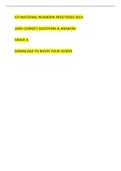Exam (elaborations)
ATI RN MATERNAL NEWBORN PROCTORED 2019(Very Reliable Study Guide)100% CORRECT QUESTIONS & ANSWERS GRADE A
- Course
- Institution
- Book
ATI RN MATERNAL NEWBORN PROCTORED 2019 1. A nurse is caring for a client who is 2 weeks postpartum following a cesarean birth. Which of the following clinical findings should the nurse identify as an indication of postpartum infection? i. Mastitis - painful or tender localized hard mass and red...
[Show more]



